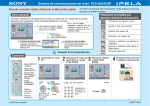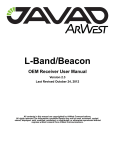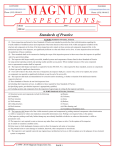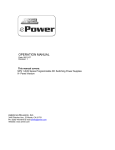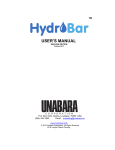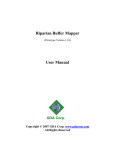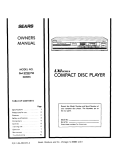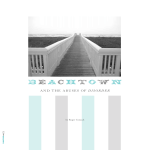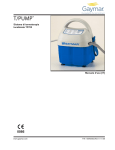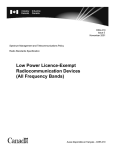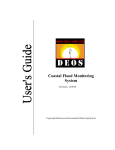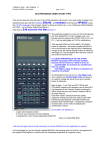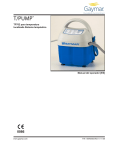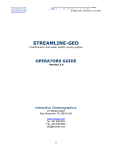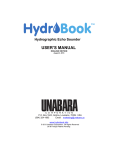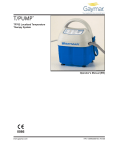Download Field Procedures - EDIS
Transcript
Field Procedures Tide Gauge Installation Once appropriate tide gauge sites were established, secure facilities were found where gauges could be installed. Each proposed gauge site was visited to confirm the presence of vertical benchmarks and their suitability to determine tide gauge elevation. The majority of benchmarks were located within sight of the tide gauge installation, such as on a seawall or on an adjacent road or structure. A licensed surveyor was hired to establish vertical control for one gauge installation. Tide gauge stilling wells were securely fastened to a protected piling or other suitable mounting location (Figure 5F) using stainless steel straps, similar to automotive hose clamps, but available in lengths of 4 feet or longer. An I-beam of 2 x 4 lumber, securely screwed together and placed between the stilling well and piling, provided a stable mount with a suitable standoff distance. The field crew carefully monitored the gauge’s elevation relative to the piling to check for vertical slippage or other problems. Tide gauge vertical control, relative to NGVD29 or NAVD88, was determined by differential leveling (double running) conducted by project personnel. When the benchmark was located on a seawall, simultaneous measurements to the water surface from both the gauge and benchmark were used to establish gauge elevation. The average of three or more measurements, made under calm conditions, was used to establish the gauge elevation. From other benchmarks, not located on seawalls, the gauge elevation was established via differential leveling. The MLLW tidal datum was determined in reference to an historical NOS tidal benchmark located in the study area. The NOS tidal benchmark sheet provided elevations of tidal and geodetic datums referenced to MLLW (feet). Tidal benchmark sheets were obtained from the following NOAA web site: http://co-ops.nos.noaa.gov/ bench.html. During installation of the tide gauge, critical parameters were recorded, including benchmark characteristics and a record of the procedures and measurements obtained during tide gauge calibration and leveling procedures. This information was of vital importance when correcting depth measurements to the MLLW tidal datum. Tide corrections were performed by means of a computer program, Survey Tide Correction (SURVCORR.exe), developed by the University of Florida (UF) Coastal and Oceanographic Engineering program. SURVCORR was developed to correct depths within a winding canal or river system. The program, with inputs of spatially referenced soundings and tide gauge readings, determines and applies depth corrections based on time and relative location. Tide data are interpolated to each centerline, or user-constructed baseline point, by assuming a linear variation of the tide through the system. Weighting the interpolation by the distance from a gauge provides correction for non-linear effects, such as viscous dissipation. A more detailed description of the program can be found in the Appendix B. Setting the Tide Gauge Data Logger After the tide gauge stilling well was secured in its operating position and nearby benchmarks identified to serve as elevation references, the data logger was set for a 6-minute logging interval, in accordance with the Infinities user manual (Infinities USA, Inc. 1999), using a Hewlett–Packard HP48GX calculator. Several data logger readings and nearly simultaneous staff gauge or tape measure determinations of drop to the water surface from the stilling well rim (which corresponds to the logger’s transducer height) were made. The readings were recorded and compared, and if the 11 logger sounding error exceeded the specified limit (1 percent of reading), the logger was calibrated using the logger’s built-in calibration routine. Each tide station data logger was downloaded at least weekly, preferably more often, in order to ensure data were not lost due to “wrapping,” which occurs when the logger’s memory is full and each new record causes deletion of the oldest record in storage. Frequent visits to a tide station were made to reveal problems (malfunctions, stilling well movement, theft, vandalism, etc.) to avoid loss of many days of soundings taken that could not be corrected for tides. DSM212H DGPS Parameter Settings Feature positional accuracy obtained during data collection depended on several factors including the number of satellites, multipath, distance between base station and the rover, Positional Dilution of Precision (PDOP), Signal-to-Noise Ratio (SNR), and satellite elevation (Trimble Navigation Ltd. 1995). These factors were controlled and monitored via software and hardware settings. The following discussion describes the parameter settings used for field data collection The Trimble DSM212H and its integrated dual-channel MSK beacon receiver were configured using Trimble Standard Interface Protocol (TSIP) TALKER software installed on the AMREL laptop. The TSIP TALKER software was used to configure key GPS operating parameters (DGPS input and output and NMEA-0183 output messages) as well as to monitor the status of receiver processes. The Elevation Mask was set to 15 degrees, PDOP Mask to 6.0, Dynamics Code to land, and the Positioning Mode to Manual 3D. The Positioning Rate, which was set to 1 Hertz (Hz), determined the rate at which the DSM212H output position reports to the HYPACK hydrographic software. Radiobroadcast USCG DGPS stations served as the DGPS Source for position corrections. Beacon Mode was set to automatic, which allowed the receiver to acquire the best signal from available USCG DGPS stations. DGPS Mode, which determines receiver behavior when DGPS corrections are received from a radiobeacon station, was set to ‘On’ to assure that the receiver computed positions only when DGPS corrections were available. The Max PRC Age was set to 20 seconds to eliminate older PRCs from position calculations, since they quickly age and lose accuracy. The External DGPS Source was set to ‘Any Station’ to automatically acquire DGPS corrections from any radiobeacon in the area. Depth Sounders Bathy-500MF—the Bathy-500MF echo sounder is controlled using the 16 keys located on the front panel. The settings described below are those that were found appropriate during the hydrographic survey. The field crew used only digital depth output, not the paper chart capability, of the sounder. During startup, the LCD display was viewed to determine if the unit was set to the proper transducer frequency (200 kHz transducer). The RANGE setting depends on the range of depths encountered during a particular survey; a consistent setting of 0–30 ft was used during the survey. The PHASE setting was 0–120 ft, the GAIN was set to ‘Auto’, and TVG set to 100. A daily bar check determined whether corrections were needed due to variations in sound velocity. When there was a difference between the sounder depth reading and the bar depth, sound velocity (SV) was adjusted until the two depths matched. A data output I/O format of NMEA dbs was used to transmit depths to the HYPACK software. The depth of the transducer below the waterline was determined under normal load conditions and the measurement entered into the Bathy-500MF using the OFFSET key. Alarms were set to notify the operator when sounder readings were above or below specified limits. Alarms were useful to notify the operator when the sounder gave false readings. 12 Potential causes of false readings include turbulence, temperature gradients, density variations, and biological layers. Horizon DS150—the procedures for entering settings into the Horizon echo sounder are described in the user manual (Standard Communications 2001). The keel offset (depth of the transducer below the waterline) was determined under normal load conditions (equipment and personnel) and the measurement entered into the HYPACK Hardware driver settings for the Horizon. The Display Damping setting controls for rough water conditions, schools of fish, and thermal layers, all of which can cause erratic depth readings. Display damping controls the rate that the displayed depth changes and will help remove these variations. There are three levels of damping, with d1 having the least effect and d3 having the greatest effect. When operating in shallow or at high speeds it is best to use a low level of damping. The Horizon DS150 setting for damping was set to D1. The Turbulence Setting provides three settings of turbulence rejection: t1, t2, and t3. A setting of t2 should be used unless a problem occurs while underway. A setting of t1 enables the instrument to work in water as shallow as 3 feet at an increased susceptibility to water turbulence and surface noise. A setting of t3 provides maximum immunity to water turbulence and surface noise at the expense of shallow water (less than 4 feet) performance. Survey Procedures Prior to conducting the depth survey, tide gauges were installed and checked to make sure they were working properly. There were a number of corrections that needed to be applied to the raw soundings to account for error sources attributable to systematic and system-specific instrument errors, static and dynamic variations in boat draft, environmental conditions, and tidal variations (National Ocean Service 1999; U.S. Army Corps of Engineers 2001). Instrument Error and Sound Velocity Corrections—To determine corrections for sound velocity and instrument error, bar checks were performed within the survey area. A minimum of two bar checks was conducted during each survey day to verify the depth reading from the Bathy-500MF and DS150 transducers. Bar checks took place at the start and end of each survey day. The bar consisted of a metal plate lowered to set distances, at 5-foot intervals, below each transducer. The sounder depth reading, at each 5-foot interval, was compared to the bar depth and, if necessary, the appropriate correction factor was entered into the DS150 instrument as one component of the keel offset, along with the static draft correction (see below). To apply the correction to the Bathy-500MF, the sound velocity setting was adjusted until the depth reading equaled the bar depth. At the end of each day, the two daily bar checks were compared. If the difference were greater than 0.3 foot, the survey was to be repeated; this was never necessary during the survey. Static draft corrections—The static draft correction accounts for the depth of the transducer face below the waterline. The measurement was made at least to the nearest 0.1-foot as determined under normal load conditions with boat personnel in their survey positions. A person standing on a dock next to the survey vessel made the measurement. The correction was entered into the Bathy500MF as a component of the offset, along with any necessary sound velocity correction (see Instrument Error and Sound Velocity Corrections). The correction was entered into the DS150 as a “Keel Offset”. 13 Squat and Settlement—Differential leveling conducted under normal load conditions (including personnel, fuel, and equipment) determined squat/settlement corrections to the nearest 0.1-foot for the range of survey operating speeds (0 to 6.2 knots). Squat/settlement corrections varied from 0.0 to 0.2 foot. Squat/settlement corrections were determined under calm conditions, in depths that equaled the average expected for the study area. To determine squat/settlement corrections a level was set-up on a dock and the boat run parallel to the shoreline in front of the level, at various speeds. A rod was held over the transducer and a series of observations taken with the vessel standing still, and at the range of survey operating speeds. The squat/settlement correction factor for each operating speed was based on the average of a minimum of three runs at each speed. Squat/settlement corrections were automatically applied during the depth survey by installing the Draft Table Driver within the HYPACK hydrographic survey software. The Draft Table is a listing of correction values with their corresponding vessel speeds. The average boat velocity, as determined from the DGPS, was recorded for each RPM level. Motion Corrections—The depth survey was conducted in protected, near shore waters under calm sea conditions, and correction for heave, the only motion correction applicable for a single-beam survey (National Ocean Service 1999), was unnecessary. During bathymetry data collection in the residential canal systems, the primary weather considerations were crew safety (especially with regards to lightning), collision avoidance (when maneuvering near other vessels in heavy sustained or gusty winds), and efficient operation of instrumentation (particularly in heavy rain). On workdays when conditions were suitable in those regards, the weather did not significantly affect boat dynamics in the canals, and data quality remained high. Error Budget—The following table gives the estimated measurement accuracy for depths less than or equal to 15 feet. Depth Measurement Error Budget Echo Sounder Measurement Error 0.15 feet Bathy-500 Resolution 0.1 feet Bar Check Calibration 0.15 feet Static Draft 0.1 feet Squat/Settlement 0.1 feet Tide and vertical datum 0.2 feet Resultant RMSE 0.35 feet HYPACK Software Settings A number of HYPACK software settings were necessary to conduct the depth survey. The GEODETIC PARAMETERS settings depend on the projection parameters and the coordinate system of the background imagery used for a project. The depth survey used USGS DOQQs in Albers Equal Area projection and the parameters were set as shown in the following table. HYPACK GEODETIC PARAMETERS. Geodetic Parameters Predefined Grids None Distance unit Meter Depth unit same as horizontal 14 Ellipsoid Orthometric Height Correction Projection Central Meridian Reference Latitude North Parallel South Parallel False Easting (X) False Northing (Y) WGS-84 0.00 Albers Equal Area 84o 00’ 00.0000’’W 24o 00’ 00.0000’’N 31o 30’ 00.0000’’N 24o 00’ 00.0000’’N 400000.0000 0.0000 Hardware Setup—Four device drivers were installed for the depth survey equipment to communicate properly with the HYPACK software. These included the two echo sounders: the Bathy-500MF and the DS150; and the DSM212H DGPS. A fourth device consisted of a table to quantify the relationship between boat speed and squat/settlement. The table was used to apply real-time squat/settlement corrections to raw depths during the survey. The relative location of each sensor that provides input to the HYPACK software was determined by selecting a point on the survey boat to serve as the “boat origin.” Each sensor was then referenced based on its location relative to the origin: “to starboard”(X-direction) and “forward” (Y-direction). The offset units were the same as those used to record depths (e.g., meters). Figure 6 illustrates the Key West survey vessel as configured during the depth survey, with two echo sounders and one DGPS Y-Axis (Positive Forward) GPS Antenna Y Offset X Offset X-Axis (Positive Starboard) Transducer Figure 6. Boat Equipment Layout Schematic 15 antenna. The boat origin was positioned directly over the Bathy-500MF transducer, above which was mounted the DGPS antenna. All offsets forward and starboard of the boat origin have a positive value. The DS150 Horizon transducer was located aft of (negative offset) and to the port (negative offset) of the boat origin. Once the preliminary tasks are completed, the device driver installation process was initiated. The specific settings for each survey device are detailed below. The Update frequency for the Bathy500MF controls the rate (ms) at which HYPACK requests a depth reading from the echo sounder and was set to 500 ms for the survey. The horizon outputs depths at a slower rate than does the Bathy500MF and the setting was left at 50 ms. The latency time offset for the DSM212H was set to -0.3 as determined in consultation with Coastal Oceanographics, Inc, manufacturer of the sounder. A “matrix” file for the study area was constructed in the HYPACK Max Matrix Editor. As soundings were collected, the Survey program filled in the matrix cells with pre-selected sounding colors, allowing continual monitoring of data goodness and enabling the crew to see a track generated over the background imagery as the boat moved. The survey was initiated after performing the initial bar check for each sounder. The boat followed a planned course, to sound centerlines and each side of waterways. Three parallel lines were surveyed at 25, 50, and 75 percent of the canal width. The data collector monitored the progress and directed the boat operator as required. The boat stopped when soundings were missed due to absence of DGPS positions or other causes. Audible and visible alarms alerted the crew to data dropouts. The data collector paused logging when the boat stopped or maneuvered off the planned course to avoid traffic or other hazards. When the water was too shallow for sounder operation, the data collector or boat operator manned the staff gauge. Manual soundings were noted on the aerial photomap, along with the date and time. If soundings could not be logged automatically due to excessive PDOP or loss of the beacon under bridges, near large buildings, etc., sounder readings were recorded on the map, again with the date and time. At the end of the day, a second bar check was conducted. Upon completion of the bathymetric survey, cross lines checks were performed on a different tidal cycle to verify the bathymetric data. Cross lines were at a 45 degree angle to original survey lines, their length was equal to fifteen percent of the total linear extent of the bathymetric survey, and they were distributed throughout the study area. The criterion for acceptance was an expected mean difference of ±0.2 feet between comparable survey points. 16






